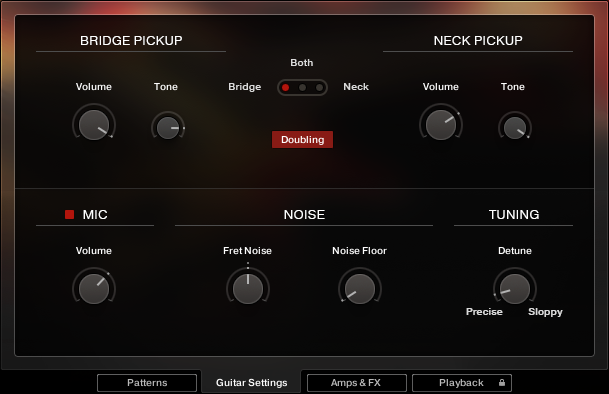The Guitar Settings Page
Adjust the sound of the Guitar itself via the Guitar Settings Page.
Click on the Guitar Settings tab (at the bottom of the instrument) to display the Guitar Settings page. This page provides controls that you can use to adjust the sound of the guitar itself, whereas the Amps & FX page provides virtual effect pedals and amplifiers. This page is divided into several sections, each of which is described below.

The Guitar Settings Page
Pickup selector: Use the pickup selector switch to choose either the bridge pickup, neck pickup, or a combination of both pickups. The bridge pickup provides a brighter sound with a stronger attack, while the neck pickup sounds softer.
Volume and Tone controls: Use these controls to adjust the volume and brightness of each pickup individually.
Mic signal: In addition to the two pickup signals, you can dial in the acoustic signal of a microphone which was mounted directly above the strings. The pickup signals and the mic signal are mixed down to a single bus, and are sent to the sound processors found on the Amps & FX page for further processing.
Note
To save memory, make sure to deactivate unused pickup and microphone signals instead of only turning their volume knob down, as each active signal requires a share of your computer’s memory.
Doubling: When this button is activated, you will hear two separate guitars playing in unison, one on the left, and one on the right. This creates a very wide stereo image.
Fret Noise: Use this knob to adjust the volume of fret noises, which are automatically added upon changing chords.
Noise Floor: Use this knob to raise the noise floor. The noise floor is switched off while the instrument is not playing.
Tuning: Use this knob to detune the guitar.
Tip
Moderate levels of noise, detune, fret noises, and a little dose of mic signal can help add realism, and create a more “tangible” guitar sound.
Tip
If you prefer to use external amp simulations instead of using the effects provided on the Amps & FX page (see The Amps & FX Page), keep in mind that stereo doubling requires two individual signal chains, i.e. one amp simulation for the left output channel and another one for the right output channel. If in doubt, listen to the stereo width: If the stereo doubled signal collapses to mono when applying external effects, the signal path is not “true stereo”.